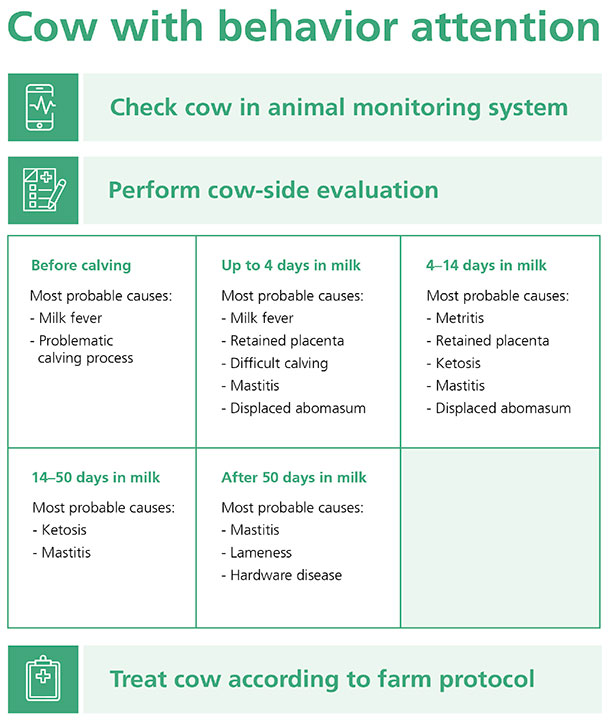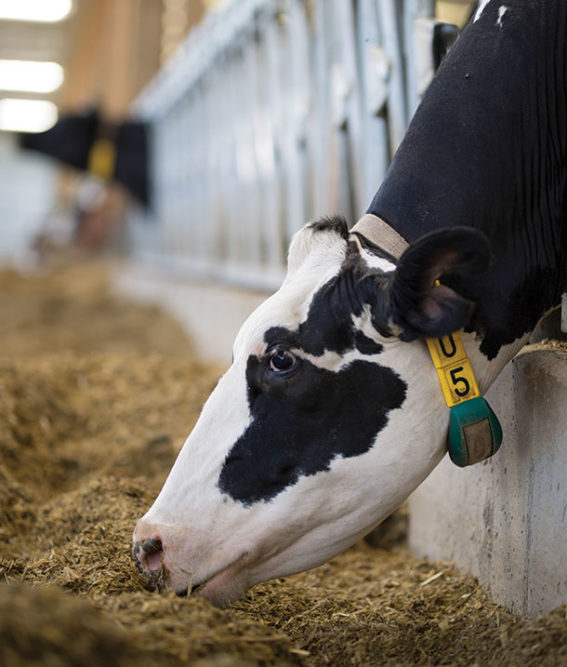What if you could know a cow is sick before she shows signs? Well, you can.
Animal monitoring systems are like a fortune teller for your cows. They can alert you when a cow is not behaving normally to identify health issues sooner, reducing treatment time, costs, labor and lost production.
Monitoring systems come in neck, leg and eartag form, and use activity, rumination, eating or lying time data to identify cow health events.
Having this data at your fingertips can help you proactively manage individual cow health and group performance for the herd. You’re able to see which cows are on par and which pens may need attention.
Here’s an overview.

Why consider an animal monitoring system for cow health?
Animal monitoring systems provide unbiased data, evaluating cows 24/7. When employees monitor cow health, you’re subject to human error and varying assessments from different employees over 24 hours.
With a monitoring system, each cow becomes her own benchmark. Most systems track individual cow performance and compare the cow to her own data from previous days. If her behavior deviates from her normal data trend, the system alerts you that something may be wrong. By getting cued into early behavior changes, you can focus on the individual cow by reviewing data from activity monitoring and herd management. Then you can complete a cowside evaluation sooner to enroll her in the necessary treatment protocol.
Another benefit of animal monitoring systems is the positive industry perception they create for the consumer eye. More accurate predictions of cow health issues allow managers to target problem cows and leave the rest of the herd alone, minimizing cow touches. And earlier intervention can help reduce antibiotic use – a win-win for the entire industry.
How long does it take to see the payoff?
Animal monitoring systems have been around for nearly two decades, and their technology continues to advance. We talked to a few herds with varying monitoring system experience.
Their return on investment (ROI) is presented in Table 1.

How are dairy farmers using animal monitoring systems for health?
Herd goals and management focus areas influence how farmers use monitoring systems. They can be valuable for monitoring short- and long-term trends. We surveyed dairy farmers using an animal monitoring system to hear their experiences:
- Pre-fresh: Some farms noted using monitoring systems to keep a closer eye on pre-fresh cows. They find cows will experience a drop in eating and rumination time a couple days before calving. And they’re catching early signs of milk fever.
- Post-calving: All farms noted finding transition issues earlier before they escalate into something more severe. They’re able to implement treatment protocols sooner and get cows feeling better faster. The most common diagnoses include milk fever, ketosis, displaced abomasum and mastitis.
- Ration changes: It’s not always easy to measure the impact of ration or feeding changes. What impact does the change have on the herd and specific groups? Is there enough feed in front of them? Do we need to adapt how often we push up feed? How is the close-up ration performing? Through monitoring feed intakes, group eating times and rumination changes, herd managers noted they can make sound assessments.
- Employee workflow: One herd manager said his system gives him “peace of mind” when it comes to employee workflow. Since the system narrows down the 1% to 2% of cows needing urgent attention, it helps his employees focus on individual cows and follow their treatment protocols. For example, if a cow is off feed or down in rumination in their post-calving group, he knows his employees will give the cow immediate attention and work through the proper protocols.
- Stocking rates: Some herd managers cited eating and rumination time as a tool for managing overcrowding and bunk space availability. These insights help them keep a closer eye on overstocked pens to ensure feedbunk and freestall availability. If lying times and eating times decrease, it is a cue pen stocking rates may be too high.
Are there other considerations for data integration?
Look at the technology you’re already using or plan to add in the future. Could a monitoring system help make the data you have stronger? Or help reveal more health insights? Consider milk weights or conductivity – if you notice a change, having a monitoring system can provide more data points through activity, eating time and rumination to investigate and make a more accurate diagnosis quicker.
Don’t be fearful of data overload. Most systems are intuitive and make the data easy to interpret. Ask for a video demo so you can see how the dashboard looks and how you would work with the information.
You can also integrate animal monitoring systems with other technologies to utilize the data in real time and capitalize on labor savings. Some dairy farmers find it helpful to add a sort gate that will sync with their monitoring system. When the system generates an alarm, the sort gate automatically sorts that cow to a separate area after milking where you can conduct a cowside evaluation.
Take a proactive approach to cow health with an animal monitoring system. Work with your milking equipment dealer to find the right system for your herd and see how it can integrate with your existing technology. Consider test driving the technology before you decide if it’s a fit. Often on-farm trials or demo software are available through your milking equipment dealer.







